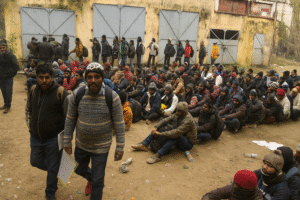The Dark Reality Behind India’s “5th Largest Economy” — Why Every War Becomes a Job Opportunity
In movies, India often plays the hero — rescuing citizens from war-torn lands, saving innocents from bombs and bullets. But in reality, history tells a very different story.
When conflicts erupt, many nations rush to evacuate their people. India, however, has an unusual pattern: it sends workers into those very war zones.
Behind the glitter of being the “world’s 5th largest economy” lies a shadow — millions of unemployed or underpaid citizens willing to risk their lives abroad for a living wage. Wars that devastate others’ lives often open economic doors for Indian migrant labour.

Israel–Gaza War (2023–2024): 20,000 Workers Sent into a War Zone
When Israel barred Palestinian labourers after the October 7, 2023 Hamas attack, its construction industry collapsed overnight. Instead of avoiding the danger, India stepped in — sending over 20,000 workers to replace the Palestinians.
The logic was clear: wages in Israel were 6–10 times higher than in India. For a worker in Uttar Pradesh or Haryana, the promise of ₹150,000+ a month outweighed the risk of rockets and sirens.
Rights groups called it “commodifying human life”, but the deployment continued, backed by government agreements and private recruiters.
Afghanistan (2001–2021): Engineers, Labourers, and Soft-Power Allies
During the U.S.-led occupation of Afghanistan, India became one of Washington’s “soft power” partners. While Indian troops did not join combat, thousands of engineers, technicians, and labourers were sent to rebuild roads, dams, and government buildings — often in high-risk Taliban territories.
Projects like the Salma Dam and Zaranj–Delaram Highway were built under the shadow of suicide bombings and kidnappings. Several Indian workers lost their lives, yet the flow of labour continued.
Iraq After the 2003 Invasion: Labour on the Frontlines of Reconstruction
Following the fall of Saddam Hussein, Iraq’s oil and construction sectors needed manpower. Indian workers filled the gap — in oil refineries, infrastructure projects, and even in non-combat roles on U.S. military bases.
In 2004, three Indian truck drivers were kidnapped by insurgents, sparking a diplomatic crisis — yet recruitment to Iraq did not stop.
Libya (2011), South Sudan, and Other Conflict Zones
-
Libya 2011 – Before the civil war, 18,000 Indians worked there. Even as fighting escalated, some continued in “safe” areas until evacuation became inevitable.
-
South Sudan Civil War – Indian oil engineers and UN peacekeepers worked under the threat of militia attacks.
-
Gulf Wars – During the 1990–91 Gulf War, over 170,000 Indians were in Kuwait when Iraq invaded. While most nations evacuated their citizens, many Indian workers returned to the Gulf soon after for work.
Why This Keeps Happening
-
Massive Wage Gap – A construction worker in India might earn ₹15,000–₹20,000 per month; in a war zone abroad, the pay can exceed ₹150,000.
-
Chronic Unemployment – Despite economic growth statistics, India struggles to provide enough domestic jobs for its youth.
-
Political Alignment – India often maintains good relations with both warring sides, making such deployments politically feasible.
-
Labour Demand in War Zones – Wars displace local workers, creating urgent vacancies that India is quick to fill.
The Ethical Question
The contradiction is striking: a nation that celebrates its global economic ranking and portrays itself as a safe haven in its media narratives is, in practice, willing to send its poorest citizens into the heart of danger for foreign profit.
This raises hard questions:
-
Should economic desperation be a reason to risk citizens’ lives in active conflict zones?
-
Is the “5th largest economy” title hollow if millions must seek work in war zones?
-
Who is accountable when these workers are killed or injured far from home?
From Israel today to Afghanistan yesterday, and Iraq, Libya, and beyond — the pattern is consistent. War for some nations means tragedy; for India, it often becomes a labour export opportunity.
Until unemployment, wage disparity, and labour exploitation are addressed at home, India’s poorest will continue to be sent into the world’s most dangerous places — not as soldiers, but as survival-driven migrants.
















